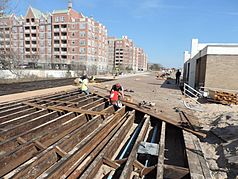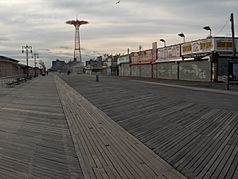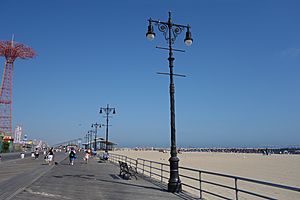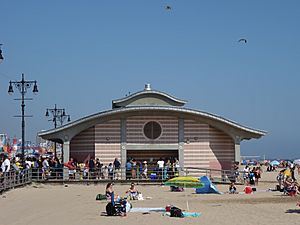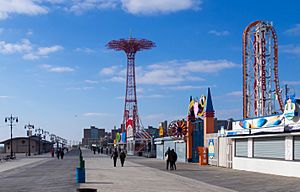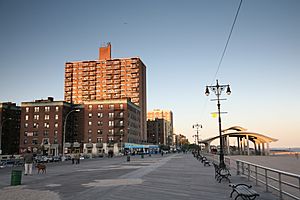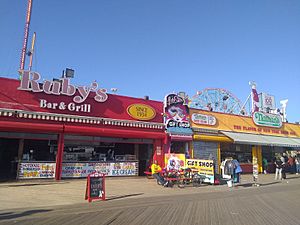Riegelmann Boardwalk facts for kids
Quick facts for kids Riegelmann Boardwalk |
|
|---|---|
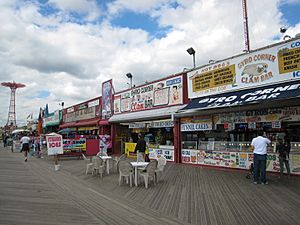
Shops along the boardwalk, with the Parachute Jump in the background
|
|
| Location | Coney Island, New York |
| Nearest city | New York City |
| Area | 2.7 miles (4.3 km) long by 50 to 80 feet (15 to 24 m) wide |
| Created | 1923 |
| Operated by | New York City Department of Parks and Recreation |
| Open | 6 a.m. to 1 a.m. |
| Status | Open |
The Riegelmann Boardwalk, also known as the Coney Island Boardwalk, is a famous walkway in Brooklyn, New York City. It stretches for about 2.7 miles (4.3 km) along the southern shore of the Coney Island area, right next to the Atlantic Ocean. This boardwalk opened in 1923 and connects many fun places, from West 37th Street near Sea Gate to Brighton 15th Street in Brighton Beach. The New York City Department of Parks and Recreation (NYC Parks) takes care of it.
The Riegelmann Boardwalk is mostly made of wooden planks laid out in a cool zigzag pattern. It's about 50 to 80 feet (15 to 24 m) wide and sits a bit above the ocean. It links up popular spots like the New York Aquarium, Luna Park, Deno's Wonder Wheel Amusement Park, and MCU Park. The boardwalk is a huge symbol of Coney Island and has appeared in many movies, songs, and art. People even say it's one of the most important public projects in Brooklyn, like the Brooklyn Bridge.
Before the boardwalk was built, the Coney Island waterfront was split up by private owners who put up fences. People started talking about building a boardwalk in the late 1890s to connect all the different parts of Coney Island and make the area better. Philip P. Farley designed the boardwalk, and it was named after Edward J. Riegelmann, who was the Brooklyn borough president and helped make it happen. The first part of the Riegelmann Boardwalk opened in 1923. It was made longer in 1926 and 1941, and it has been fixed up many times over the years. In 2018, the New York City Landmarks Preservation Commission made the Riegelmann Boardwalk a city landmark, which means it's a special historic place.
Contents
What is the Coney Island Boardwalk Like?
How Long and Wide is the Boardwalk?
The Riegelmann Boardwalk stretches for about 2.7 miles (4.3 km). It goes from West 37th Street, where Coney Island meets Sea Gate, all the way to Brighton 15th Street in Brighton Beach. For most of its length, the boardwalk is 80 feet (24 m) wide. However, some parts in Brighton Beach are a bit narrower, at 50 feet (15 m) wide. It's built about 13 or 14 feet (4.0 or 4.3 m) above sea level. This height helps protect it from big waves during storms.
In 1923, it was explained that the raised boardwalk was designed to have "plenty of clear space" underneath. This space runs both parallel and across the boardwalk. You can get down to the beach using staircases and ramps, which are placed about every 1.5 blocks or 300 feet (91 m). There are also ramps connecting the boardwalk to the streets on the north side.
What is the Boardwalk Made Of?
The boardwalk has a strong base of steel and concrete. On top of this, there are wooden planks that form the walking surface. However, much of this base isn't visible anymore because the beach sand was raised after the boardwalk was built. A lot of materials were used to build it, including a huge amount of sand, stone, reinforced concrete, and timber for the floor. To stop strong waves from hitting the boardwalk, sixteen rock walls called jetties were built. These jetties are spaced about 600 feet (183 m) apart. The beaches here aren't natural; sand is brought in to keep them wide and sandy.
The boardwalk was built to hold a lot of weight, up to 125 pounds per square foot (610 kg/m2). The designer, Philip Farley, used a special concrete structure underneath. Strong piles were placed every 20 feet (6 m), with each pile having four reinforced concrete sections.
The wooden planks on the boardwalk are laid in a special zigzag pattern, at 45-degree angles. This diagonal design was meant to make it easier to walk. There are also 6-foot-wide (1.8 m) wooden paths that run straight, which were designed for chairs to be rolled along. The boardwalk was first built with strong wood from Washington state. In recent years, even tougher woods, as well as plastic and concrete, have been added. The boardwalk is also a bike lane from 6 a.m. to 9 p.m. every day, except during summer mornings when cycling stops after 10 a.m.
What Can You Find on the Boardwalk?
Along the boardwalk, you'll find restrooms, benches, and drinking fountains. Some are on the boardwalk itself, and some are underneath. In 1925, five pavilions and five pergolas were built, but they are no longer there. They had a Mediterranean Revival style with arched doors and tiled roofs. There were also "comfort stations" (restrooms) under the boardwalk with cool stairs and rooftop terraces. Most of the shade pavilions you see today were built in the 2000s and 2010s. They are raised high to meet storm safety rules. There are also some old, non-working iron fountains and newer, working steel fountains.
The boardwalk's first street lights were twin-lamp lights, similar to those on Fifth Avenue in Manhattan. These lights are placed every 80 feet (24 m) and at street corners. The original benches that faced the ocean have been replaced over time.
Fun Attractions on the Boardwalk
Today, some of the most popular attractions on the boardwalk include Luna Park, Deno's Wonder Wheel Amusement Park, and the New York Aquarium. The boardwalk is also next to MCU Park, which opened in 2001. This park is home to the Brooklyn Cyclones, a Minor League Baseball team. A concert venue called the Ford Amphitheater at Coney Island opened on the boardwalk in 2016. Some older amusement parks that used to be here, like Steeplechase Park and the original Luna Park, are no longer around.
There are several famous landmarks right on the boardwalk. The Childs Restaurants building, now the Ford Amphitheater, opened in 1923. Its design was made to fit in with the boardwalk. East of it is the Parachute Jump, a tall, old ride that is 250 feet (76 m) high. It's a city landmark and listed on the National Register of Historic Places. The B&B Carousell, next to the Parachute Jump, is the last working carousel in Coney Island and is also a historic place. The Coney Island Cyclone, a wooden roller coaster built in 1927, is the only old roller coaster still running in Coney Island. It's both a city and national landmark. A bit inland from the boardwalk is the Wonder Wheel (built 1920), a 150 feet (46 m) tall Ferris wheel that is also a city landmark. Other fun spots include the Thunderbolt roller coaster, the Abe Stark Recreation Center, and many small rides, shops, and restaurants.
A large wall art piece called The First Symphony of the Sea was put up along the boardwalk outside the New York Aquarium in 1993. It's 332 feet (101 m) long and 10 feet (3.0 m) tall. It shows waves, fish, and tiny marine life using colorful tiles.
Steeplechase Pier
Steeplechase Pier is the only pier left on Coney Island's beach. It goes 1,040 feet (317 m) out into the ocean from the boardwalk at West 17th Street. It's close to where Steeplechase Park used to be. The pier was built by 1904 and was once about 2,000 feet (610 m) long. People used to say the view from the pier was amazing, with all the twinkling lights of Coney Island. It was used by people fishing and, until 1932, by ferries going to Coney Island.
The first Steeplechase Pier was built quickly by F. J. Kelly. It was given to the city in 1921, just before the boardwalk was built, and reopened in 1922. Over the years, the pier was damaged many times by hurricanes, fires, and boat crashes. The worst was a fire in 1957 that destroyed it. A bigger pier was built the next year. The pier was most recently rebuilt in 2013 after Hurricane Sandy damaged it in 2012.
How the Coney Island Boardwalk Was Built
Why a Boardwalk Was Needed
In the mid-1800s, Coney Island became a popular vacation spot. Many resorts were built, and new train lines brought lots of visitors. But the beach itself was mostly private, owned by different people who put up fences. Some parts had small private boardwalks, but others had no way to get to the water. In 1904, it was estimated that there was very little public beach space for New York City's millions of residents. People wanted a public space where everyone could enjoy the beach.
In the 1890s, the idea of a public boardwalk grew. People saw how a similar boardwalk in Atlantic City, New Jersey, helped improve that area. In 1897, a plan for a boardwalk in Coney Island was suggested. It would run between West 37th and West 5th Streets. But property owners didn't want to give up their land or pay for it. So, only a small part was built near Seaside Park.
Other plans came up in the 1900s, but they mostly involved building a walkway over the ocean, not clearing the beachfront. In 1912, a group called the West End Improvement League pushed for a 60-foot-wide (18 m) boardwalk. This plan was supported by the city, and Coney Island residents mostly agreed. At the same time, New York State sued amusement park owners, saying the beach belonged to the state. A judge agreed in 1913, ruling that all the beach exposed at low tide was public. This meant all fences and blockages on the beach had to be removed.
Building the Boardwalk
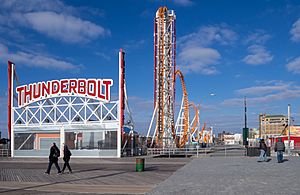
When the Coney Island–Stillwell Avenue station was finished in 1920, it became even easier to get to Coney Island. This led to huge crowds, sometimes a million people on hot days. In 1921, the state gave the city the right to buy land along the ocean in Coney Island. The city approved the boardwalk design in 1920 and got the land in October 1921. Construction began in 1922, led by engineer Philip P. Farley.
The first parts of the boardwalk structure were put up in March 1923, and the last ones were done ten months later. Some business owners tried to stop the construction, but they didn't succeed. While the boardwalk was being built, the city also improved the beach and nearby streets. Sand was brought from the seabed to make the shore wider. Timber walls and rock jetties were also installed. When it was finished, the beach could hold over half a million people.
Opening and Early Years
In April 1923, just before it was finished, the boardwalk was named after Edward J. Riegelmann, the Brooklyn borough president. He believed the boardwalk would make Coney Island more valuable. Riegelmann himself preferred it be called the "Coney Island Boardwalk." He said that once it was done, "poor people will no longer have to stand with their faces pressed against wire fences looking at the ocean."
The boardwalk opened in three stages. The first part, from Ocean Parkway to West 5th Street, opened in October 1922. It was extended to West 17th Street in December 1922. The final section, from West 17th to West 37th Street, officially opened on May 15, 1923. When it opened, people said it was wider and more expensive than other boardwalks nearby.
After the boardwalk was done, city officials said it needed more features like pergolas (shaded walkways) and restrooms. So, in 1924, the city approved building five comfort stations and five beachfront pavilions, which were finished by early 1925. The city also improved the streets leading to the boardwalk, widening some and taking over private paths. These changes cost a lot of money, but officials believed they would make Coney Island's shore better and less crowded.
The boardwalk was extended eastward to Brighton Beach in 1926. This extension was about 3,000 to 4,000 feet (910 to 1,220 m) long and made the beach bigger. There were plans to extend it westward too, but residents of Sea Gate, a private community, didn't want it to go through their area. So, the boardwalk never went past West 37th Street. In 1932, a part of the boardwalk was damaged by a fire, but it was rebuilt quickly.
Changes by Robert Moses
In 1938, the New York City Department of Parks and Recreation (NYC Parks) took over caring for the boardwalk. The Parks Commissioner, Robert Moses, thought the boardwalk wasn't well-planned or maintained. He said it was built too close to the water and didn't have enough play areas. He also mentioned that the sand used to widen the beach wasn't good quality.
Moses planned to make the boardwalk longer, extending it eastward into Brighton Beach. This would add space for 50,000 more visitors. The project involved rebuilding an 800-foot-long (240 m) section of the boardwalk, moving it 300 feet (91 m) inland, and making it straighter. This meant some buildings had to be taken down. Work started in 1940. To make it easier to get to the boardwalk, a new street was built. Also, a two-foot (0.61 m) layer of new sand was put on the entire beachfront. The moved boardwalk was finished by May 1940.
In 1941, workers extended the boardwalk even further, from Coney Island Avenue to Brighton 15th Street. This 1,500 feet (460 m) extension was narrower than the rest, at 50 feet (15 m) wide. After this, the boardwalk reached its current length of 2.7 miles (4.3 km). Moses later wanted to extend it even more to Manhattan Beach, but people there didn't want it, so that plan was stopped.
Later Years and Repairs
Throughout the late 1900s, more work was done on the boardwalk. The old street lights were replaced with new ones that looked similar. Benches, drinking fountains, and restrooms were also updated. Concrete and brick lifeguard towers were built in the 1970s.
By the 1960s, Coney Island became less popular due to more crime and fewer parking spots. The last big amusement park, Steeplechase Park, closed in 1965. The boardwalk itself started to fall apart in the 1970s. People were getting hurt from falling through rotten parts, and restrooms weren't working. In 1983, about a quarter of the wooden planks were in bad shape. City officials called the boardwalk's quality "poor." Repairs were made by 1987.
In the early 1990s, sand was added under the boardwalk to protect the shoreline. Homeless people started living there, so in 1996, the city cleared them out and fenced off the space. In 1997, a local official said the boardwalk was in "B-plus" condition, needing only minor fixes. However, residents complained about loose boards and holes. City vehicles, which were too heavy, often used the boardwalk, and there weren't enough staff to maintain it.
The Boardwalk in the 21st Century
Around the late 1990s, NYC Parks started replacing some of the boardwalk's planks with a type of wood called ipe. This was controversial because ipe wood comes from the Amazon rainforest, which worried environmental groups. New restrooms and shade pavilions were added around 2001.
By 2010, the city began renovating the boardwalk again. Some parts got new wood planks over concrete, while others were completely replaced with concrete. Using concrete was a big debate. It was cheaper and didn't require wood from the Amazon, but many people felt that wood was more traditional for a boardwalk. After trying concrete, NYC Parks suggested using a type of plastic that looked like wood. The plan to use concrete and plastic was approved in 2012.
The boardwalk was slightly damaged by Hurricane Sandy in October 2012, but the nearby amusement parks and aquarium had much worse damage. More restrooms were added in 2013. In late 2014, NYC Parks started repairing the section between Coney Island Avenue and Brighton 15th Street with concrete. This decision was still debated, but NYC Parks said it was needed due to years of wear and tear.
In December 2014, local politicians suggested making the boardwalk a city landmark. The New York City Landmarks Preservation Commission (LPC) first said no, thinking it had been changed too much. NYC Parks finished the repairs in May 2016. Even though it was rejected at first, the effort to protect the Riegelmann Boardwalk continued. In March 2018, the LPC decided to consider it again. Two months later, on May 15, 2018, the commission officially named the boardwalk one of the city's special scenic landmarks. In 2019, the city announced plans to add safety barriers at the boardwalk entrances.
Why the Boardwalk is Important
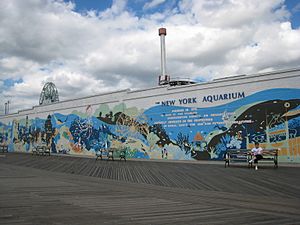
The boardwalk made the beach open to everyone, and it became known as Coney Island's "Main Street." A guidebook in 1923 called Coney Island "the oldest, most densely crowded and most democratic" amusement area in New York City. The boardwalk also brought more international visitors to Coney Island. One person from France wrote that families who couldn't go to fancy resorts came to the municipal beach on Sundays. A writer for the Brooklyn Daily Eagle said the boardwalk helped modernize Coney Island and led to new apartment buildings being built.
The boardwalk is the location for two big yearly events. The Nathan's Hot Dog Eating Contest happens every July 4 near the boardwalk. The Coney Island Mermaid Parade has taken place along the boardwalk since 1983. This parade usually happens every June and features floats and costumes. A King Neptune and Queen Mermaid are crowned at the end of each parade.
Because it's such a famous part of Coney Island, the Riegelmann Boardwalk has been shown in many artworks, songs, and movies. Artists like Harry Roseland have painted it. It's been a setting in films like Little Fugitive (1953) and Annie Hall (1977). It's also appeared in TV shows, including kids' shows like Dora the Explorer and sitcoms like Seinfeld. Music videos by artists like Beyoncé have also used the boardwalk as a backdrop.
Awards and Recognition
When it was built, the boardwalk was considered the most important public project in Brooklyn since the Brooklyn Bridge was finished in 1883. One newspaper even wrote that engineers had succeeded where "King Canute failed to halt the onward march of the tides" because they built something so strong against the ocean. The boardwalk quickly became one of Coney Island's biggest attractions. A columnist wrote in 1932 that "the boardwalk and Coney Island are now synonymous" because of its strong impact.
In 1994, the American Shore & Beach Preservation Association recognized the boardwalk as an amazing "infrastructure accomplishment." They compared it to important places like Central Park. The award noted that the boardwalk helped people who wouldn't otherwise be able to visit exclusive beaches. In 2018, the city's Landmarks Preservation Commission officially named the boardwalk a scenic landmark, recognizing its historical and cultural importance.


